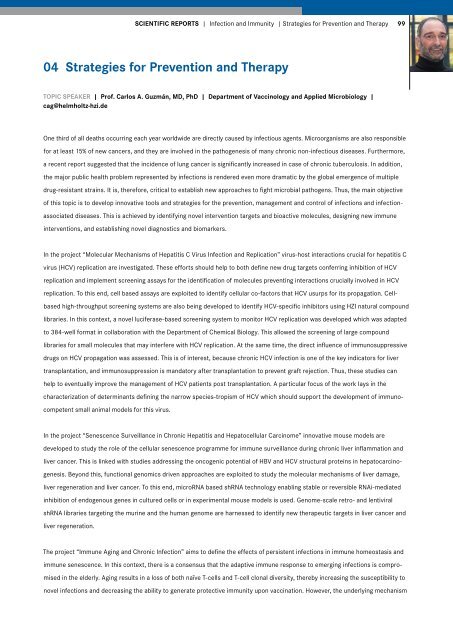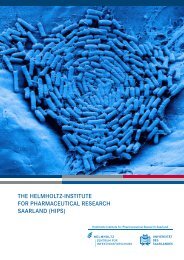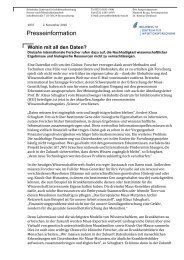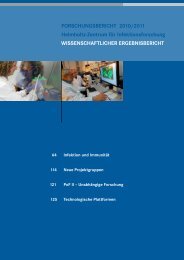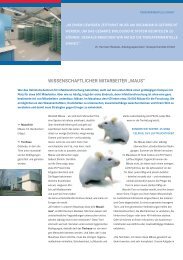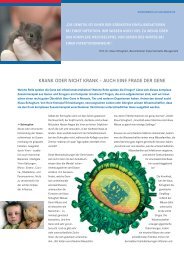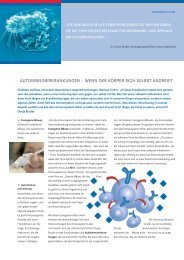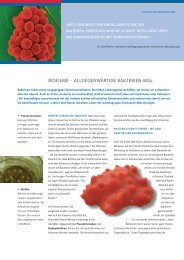Research Report 2010 2011 - Helmholtz-Zentrum für ...
Research Report 2010 2011 - Helmholtz-Zentrum für ...
Research Report 2010 2011 - Helmholtz-Zentrum für ...
You also want an ePaper? Increase the reach of your titles
YUMPU automatically turns print PDFs into web optimized ePapers that Google loves.
SCIENTIFIC REPORTS | Infection and Immunity | Strategies for Prevention and Therapy<br />
99<br />
04 Strategies for Prevention and Therapy<br />
TOPIC SPEAKER | Prof. Carlos A. Guzmán, MD, PhD | Department of Vaccinology and Applied Microbiology |<br />
cag@helmholtz-hzi.de<br />
One third of all deaths occurring each year worldwide are directly caused by infectious agents. Microorganisms are also responsible<br />
for at least 15% of new cancers, and they are involved in the pathogenesis of many chronic non-infectious diseases. Furthermore,<br />
a recent report suggested that the incidence of lung cancer is signifi cantly increased in case of chronic tuberculosis. In addition,<br />
the major public health problem represented by infections is rendered even more dramatic by the global emergence of multiple<br />
drug-resistant strains. It is, therefore, critical to establish new approaches to fi ght microbial pathogens. Thus, the main objective<br />
of this topic is to develop innovative tools and strategies for the prevention, management and control of infections and infectionassociated<br />
diseases. This is achieved by identifying novel intervention targets and bioactive molecules, designing new immune<br />
interventions, and establishing novel diagnostics and biomarkers.<br />
In the project “Molecular Mechanisms of Hepatitis C Virus Infection and Replication” virus-host interactions crucial for hepatitis C<br />
virus (HCV) replication are investigated. These efforts should help to both defi ne new drug targets conferring inhibition of HCV<br />
replication and implement screening assays for the identifi cation of molecules preventing interactions crucially involved in HCV<br />
replication. To this end, cell based assays are exploited to identify cellular co-factors that HCV usurps for its propagation. Cellbased<br />
high-throughput screening systems are also being developed to identify HCV-specifi c inhibitors using HZI natural compound<br />
libraries. In this context, a novel luciferase-based screening system to monitor HCV replication was developed which was adapted<br />
to 384-well format in collaboration with the Department of Chemical Biology. This allowed the screening of large compound<br />
libraries for small molecules that may interfere with HCV replication. At the same time, the direct infl uence of immunosuppressive<br />
drugs on HCV propagation was assessed. This is of interest, because chronic HCV infection is one of the key indicators for liver<br />
transplantation, and immunosuppression is mandatory after transplantation to prevent graft rejection. Thus, these studies can<br />
help to eventually improve the management of HCV patients post transplantation. A particular focus of the work lays in the<br />
characterization of determinants defi ning the narrow species-tropism of HCV which should support the development of immunocompetent<br />
small animal models for this virus.<br />
In the project “Senescence Surveillance in Chronic Hepatitis and Hepatocellular Carcinome” innovative mouse models are<br />
developed to study the role of the cellular senescence programme for immune surveillance during chronic liver infl ammation and<br />
liver cancer. This is linked with studies addressing the oncogenic potential of HBV and HCV structural proteins in hepatocarcinogenesis.<br />
Beyond this, functional genomics driven approaches are exploited to study the molecular mechanisms of liver damage,<br />
liver regeneration and liver cancer. To this end, microRNA based shRNA technology enabling stable or reversible RNAi-mediated<br />
inhibition of endogenous genes in cultured cells or in experimental mouse models is used. Genome-scale retro- and lentiviral<br />
shRNA libraries targeting the murine and the human genome are harnessed to identify new therapeutic targets in liver cancer and<br />
liver regeneration.<br />
The project “Immune Aging and Chronic Infection” aims to defi ne the effects of persistent infections in immune homeostasis and<br />
immune senescence. In this context, there is a consensus that the adaptive immune response to emerging infections is compromised<br />
in the elderly. Aging results in a loss of both naïve T-cells and T-cell clonal diversity, thereby increasing the susceptibility to<br />
novel infections and decreasing the ability to generate protective immunity upon vaccination. However, the underlying mechanism


